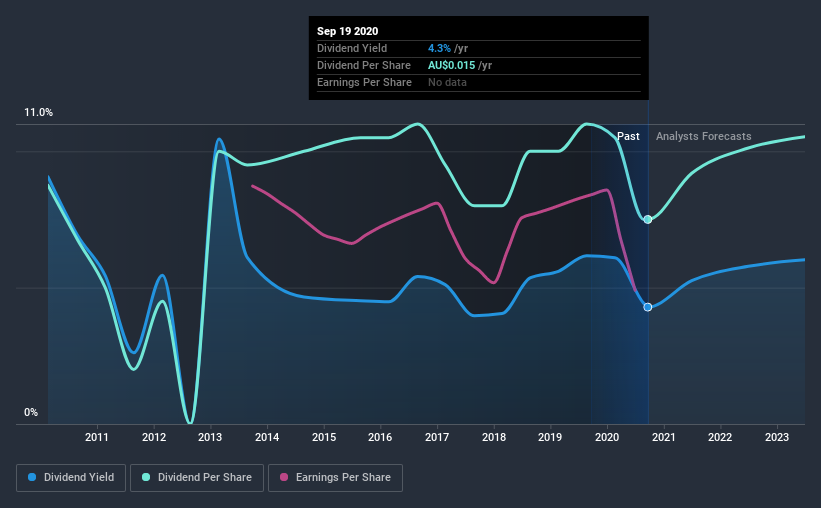Lindsay Australia Limited (ASX:LAU) Goes Ex-Dividend Soon

Regular readers will know that we love our dividends at Simply Wall St, which is why it's exciting to see Lindsay Australia Limited (ASX:LAU) is about to trade ex-dividend in the next four days. You can purchase shares before the 24th of September in order to receive the dividend, which the company will pay on the 9th of October.
Lindsay Australia's next dividend payment will be AU$0.005 per share. Last year, in total, the company distributed AU$0.015 to shareholders. Last year's total dividend payments show that Lindsay Australia has a trailing yield of 4.3% on the current share price of A$0.35. We love seeing companies pay a dividend, but it's also important to be sure that laying the golden eggs isn't going to kill our golden goose! We need to see whether the dividend is covered by earnings and if it's growing.
View our latest analysis for Lindsay Australia
Dividends are typically paid from company earnings. If a company pays more in dividends than it earned in profit, then the dividend could be unsustainable. It paid out 84% of its earnings as dividends last year, which is not unreasonable, but limits reinvestment in the business and leaves the dividend vulnerable to a business downturn. We'd be worried about the risk of a drop in earnings. Yet cash flow is typically more important than profit for assessing dividend sustainability, so we should always check if the company generated enough cash to afford its dividend. What's good is that dividends were well covered by free cash flow, with the company paying out 23% of its cash flow last year.
It's positive to see that Lindsay Australia's dividend is covered by both profits and cash flow, since this is generally a sign that the dividend is sustainable, and a lower payout ratio usually suggests a greater margin of safety before the dividend gets cut.
Click here to see how much of its profit Lindsay Australia paid out over the last 12 months.
Have Earnings And Dividends Been Growing?
Businesses with shrinking earnings are tricky from a dividend perspective. If earnings decline and the company is forced to cut its dividend, investors could watch the value of their investment go up in smoke. With that in mind, we're discomforted by Lindsay Australia's 5.8% per annum decline in earnings in the past five years. Ultimately, when earnings per share decline, the size of the pie from which dividends can be paid, shrinks.
The main way most investors will assess a company's dividend prospects is by checking the historical rate of dividend growth. Lindsay Australia has seen its dividend decline 1.5% per annum on average over the past 10 years, which is not great to see.
Final Takeaway
Should investors buy Lindsay Australia for the upcoming dividend? The payout ratios are within a reasonable range, implying the dividend may be sustainable. Declining earnings are a serious concern, however, and could pose a threat to the dividend in future. While it does have some good things going for it, we're a bit ambivalent and it would take more to convince us of Lindsay Australia's dividend merits.
With that being said, if dividends aren't your biggest concern with Lindsay Australia, you should know about the other risks facing this business. In terms of investment risks, we've identified 4 warning signs with Lindsay Australia and understanding them should be part of your investment process.
We wouldn't recommend just buying the first dividend stock you see, though. Here's a list of interesting dividend stocks with a greater than 2% yield and an upcoming dividend.
This article by Simply Wall St is general in nature. It does not constitute a recommendation to buy or sell any stock, and does not take account of your objectives, or your financial situation. We aim to bring you long-term focused analysis driven by fundamental data. Note that our analysis may not factor in the latest price-sensitive company announcements or qualitative material. Simply Wall St has no position in any stocks mentioned.
Have feedback on this article? Concerned about the content? Get in touch with us directly. Alternatively, email editorial-team@simplywallst.com.

 Yahoo News
Yahoo News 

